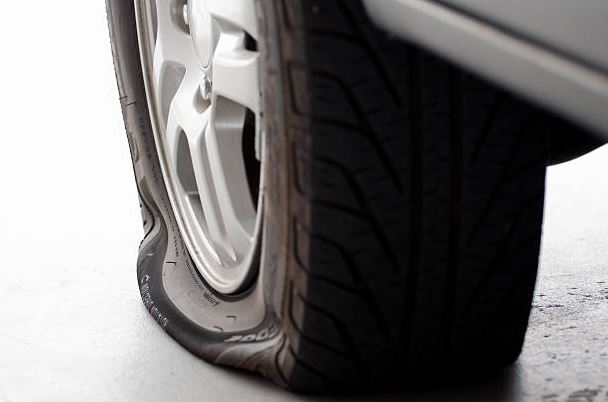Professional tire fitters claim you can go as far as 50 miles (80.4 kilometers) when driving on a flat tire without damaging the rim. But how practical is this, and does it even apply to all tire types and scenarios?
Having a flat tire in the middle of nowhere is a nightmare for every car owner, especially when there is no spare tire around or you are in an emergency. While you can manage the situation by driving slowly, you might wonder how many miles you can squeeze on your flat tire.
This article will walk you through the limits of driving on a flat tire, what to expect when attempting this Type of journey, how far can you drive on a flat tire before damaging the rim and some smart tips for making it back safely.
Table of Contents
So How Far Can You Drive On A Flat Tire Without Damaging the Rim?
It is never safe or ideal to drive on a flat tire. But if you have no choice, then make sure the distance you cover on a flat tire is at most 50 miles at speeds up to 55 mph. Otherwise, you can cause damage to the rims of your wheels and irreparable damage to the tire.
In essence, where you are going with the flat tire is not too far. However, the rims are just one part of your car that is at stake when you drive on flat tires for a long time. Such an attempt can damage other car parts like brakes, suspension, steering systems, and wheels.
In this light, fixing a flat tire quickly saves time and money rather than creating room for reduced handling, additional damage, and repair cost.
What to Consider When Driving on a Flat Tire
It is important to admit that how far you can drive on a flat tire depends on some factors. In other words, the numbers or mileage quoted by professional fitters will only apply in some cases. Therefore, before you take the risk of driving on a flat tire, consider the following factors:
The Type of tire
While standard tires do not stand a chance of keeping you rolling for long, Run-Flat technology tires can cover a significant distance without risking rim damage or other potential dangers.
However, before taking the risk, you must also confirm the distance and speed required for the Run-Flat tire (which varies from manufacturer to manufacturer). Pirelli, Continental, and Goodyear are among the manufacturers that make run-flat tires.
The load or weight on that tire
It would help if you also consider the load or weight on the tire before deciding to continue driving after it suffers deflation. If too much weight is on the tire, you can only travel a mile or two before damaging the rim.
What speed do you try to drive at
Generally, you’d want to drive slowly after getting a flat tire. However, take the required mileage seriously, so the tire doesn’t disintegrate on the block before reaching the nearest tire shop.
What Type Of Damage Happens To The Rim When Driving on a Flat Tire?
You expose the rim to corrosion damage when you keep driving on a flat tire for a long time.
The rim of your wheel is designed in a way that makes it vulnerable to corrosion due to a less protective coating compared to the outer part. So when the rim is exposed, it leads to corroding, resulting in loss of structural integrity.
How To Know You Have A Flat Tire While Driving
The best way to notice that you have a flat tire while driving is to look at the TPM signal on your dashboard. You have a flat tire if the TPM shows anything below 20 PSI.
There are generally three ways your tire can lose air pressure while driving. It is either due to punctures, loose valves, or blowouts.
If the PSI on the TPM signal is dropping at an alarming rate, it means your tire has already blown out, and you need to react quickly. The first thing is to remain calm and reduce the speed of your drive. This will help your tire survive the disaster before getting to the next tire shop.
Do I Need To Replace All Tires If I Get A Flat?
There is nothing dangerous about replacing only a single tire that got flat, but there are good reasons to avoid replacing only one tire.
You achieve optimum vehicle handling and increased ride comfort when you get a single flat and replace the other tires.
Tire fitters recommend having all four tires replaced simultaneously whenever you get a flat, as this guarantees optimum road traction.
Why Do I Always Get Flat Tires?
The common cause of frequent flat tires is wheel leaks. Otherwise known as a leaky tire bead, this component is the rubber edge where the tire fits the vehicle’s rim.
If the connection is not secured or suffers a leak, you may experience more flat tires than normal. Some mechanics call this problem “rim leaks or bead-seat leaks.”
Before You Go…
Now that we have looked at how far you can drive on a flat tire without compromising your safety or vehicle let me reiterate here that the distance you can travel ultimately depends on your car’s and tire manufacturer’s specifications.
So the best thing to do is avoid driving on a flat.
Meanwhile, when you replace your flat tire, it would help if you considered a run-flat tire. The interior of these special tires is designed to reduce impact in the event of a puncture while driving at normal speed.
It would also help if you considered taking a spare tire along on any trip for an instant change. Even if you can cover some distance after a puncture, the less time the flat tire is on the road, the better.

